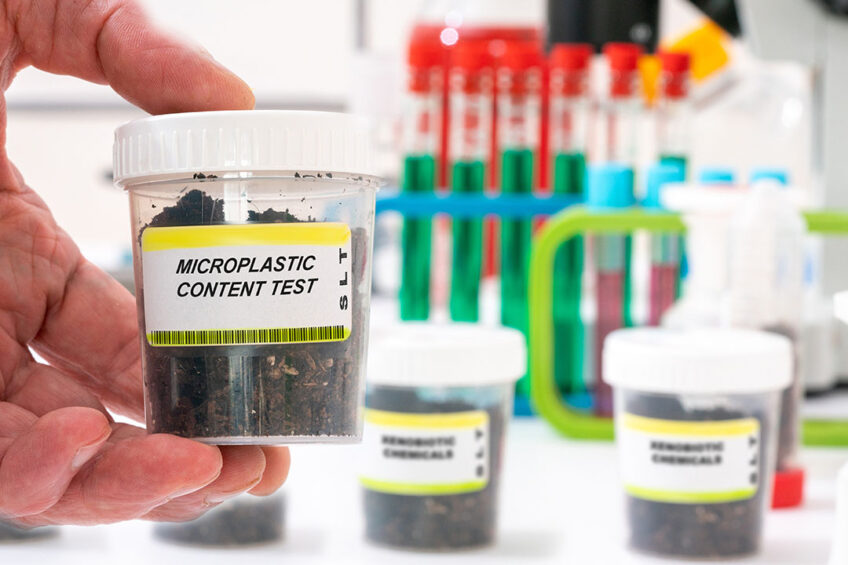Gut health implications of microplastics on poultry

A new study shows how microplastics induce gut microbial dysbiosis and metabolic disorders in broiler chickens. Researchers see the findings as a wake-up call for the feed industry worldwide to scan for the presence of plastics in feed ingredients and take note of its possible effects on animal health.
Studies show that the direct or indirect threat of microplastic contamination on public health and animal husbandry is increasing. Several studies indicate microplastics can travel up the food chain to higher-level organisms or enter the human food chain, including through aquatic products, meat and salt. Numerous studies have been conducted to explore the accumulation and absorption of microplastics in various species and the consequential negative effects. For instance, microplastic ingestion was found to cause metabolic disorders in zebrafish and reduce oyster reproduction, and contaminate feed ingredients such as fishmeal. Besides the wealth of data showing how microplastics affect the physiology and behaviour of aquatic species, their effects on poultry are less well known. This 2023 study published in the journal Science of the Total Environment explored the adverse effects and mechanisms of microplastic exposure on chicken health, given that they compromise microbial homeostasis and intestinal metabolism.
Microplastics study
To evaluate how microplastics affect growth and gut health in broilers, the researchers used day-old healthy Arbor Acres broiler chickens in a 28-day experiment. All the chickens were acclimatised for an initial 3 days to reduce stress response before being randomly divided into a control group (no microplastics) and a microplastics group (with the addition of 200 mg/kg polyethylene microplastics); each group with 30 chickens.
Growth performance and antioxidant ability
The results of the study indicated that microplastic exposure significantly decreases the growth performance of chickens, as reflected in reductions in weight gain in the microplastics group. The researchers also observed a significant decrease in the antioxidant capacity of chickens, characterised by lower levels of total antioxidant capacity and antioxidant enzymes, superoxide dismutase and glutathione peroxidase. In line with these observations, malondialdehyde (MDA), a marker for oxidative stress and antioxidant status, showed higher levels in birds offered the microplastics diet. The reduction in growth performance was attributed to the contribution of microplastics to oxidative stress and function impairment of major organs, including the liver, kidney and spleen. The histopathological changes showed that the liver, kidney and spleen in the control group exhibited regular and normal structures with no obvious pathological changes, while microplastic exposure resulted in liver inflammation, renal glomerular hypoplasia and white pulp lymphopenia. Moreover, the intestinal villi of control chickens were intact and well-defined, whereas those in the microplastic-exposed populations were arranged loosely, irregularly and in a disorderly manner.
Gut microbial homeostasis
Gut microbiota have multiple physiological functions due to their high diversity and complex interactions which are essential for intestinal homeostasis and host health. Typically, the gut microbiota are in relatively stable equilibrium which is necessary for the intestine to perform its physiological functions.
Previous investigations demonstrated that a dysbiosis of gut microbiota impairs intestinal mucosal immunity and its barrier function, increasing susceptibility to pathogens. Consistent with that previous research, this study showed that exposing chickens to microplastics for 28 days causes gut microbial dysbiosis, characterised by a significant decline in microbial diversity and abundance. Remarkably, most of the altered bacteria in this study displayed a downward trend, and 14 bacterial genera even disappeared from the gut microbiota of microplastic-induced chickens, demonstrating the failure of these bacteria to adapt to the changed intestinal environment. Some quantitatively decreased bacteria (Butyricicoccus, Ruminococcus, Christensenellaceae_R_ 7_group, Lachnospiraceae_UCG_010, Bacteroides, Blautia, Bifidobacterium, Intestinimonas and Lactococcus) are beneficial intestinal bacteria. Bifidobacterium and Lactococcus are known to possess multiple important biological properties such as promoting nutritional digestion and absorption, secreting antimicrobial peptides and improving immunity and growth performance. On the other hand, Blautia, Ruminococcus and Lachnospiraceae are potential producers of short-chain fatty acids (SCFAs). SCFAs play key roles in the provision of energy, cell proliferation, intestinal metabolism and the immune system. Studies show SCFAs can also regulate gut microbiota and the intestinal barrier function – critical for host health. In addition, pathogenic bacteria Aerococcus, Enterococcus and Turicibacter were significantly increased in the chickens exposed to microplastics.
Gut metabolism
Gut-residing bacteria can secrete various metabolites with specific biological functions that play important roles in information transfer between gut microbiota and host cells. These metabolites can also act on other organs including the liver, kidney and brain through the portal and systemic circulation systems, thereby more consistently regulating host health. Thus, the researchers conducted untargeted metabolomics to explore the shifts in intestinal metabolites in chickens during microplastic exposure. It was found that exposure to microplastics negatively affects 5 metabolic pathways (D-Amino acid metabolism, ABC transporters, vitamin digestion and absorption, mineral absorption, and histidine metabolism).
The researchers observed a significant change in the amino acid metabolism pathway, accompanied by a significant decrease in L-Serine and ornithine levels. L-Serine exhibits multiple metabolic functions in different developmental stages, such as providing precursors for synthesising neurotransmitters, proteins, phosphoglycerides, sphingolipids and phosphatidylserine. As a crucial component of the urea cycle, ornithine can reduce ammonia concentration in the organism by reacting with the ammonia produced by amino acid metabolism, thereby decreasing the toxic effect of ammonia on cells. Additionally, microplastic exposure resulted in significant changes in vitamin and mineral absorption pathways and reductions in several associated metabolites, such as riboflavin. Riboflavin is involved in the energy metabolism of protein, carbohydrates and fat, as well as the redox reaction of lipids and amino acids, which contributes to improving energy use and maintaining host health.
The study also showed decreased levels of L-Glutamine and carnosine in the microplastic-induced chickens. Studies have indicated L-Glutamine strengthen host antioxidant ability and immune system function by increasing glutathione reserves in tissue cells and stimulating lymphocyte proliferation, while carnosine has been demonstrated to scavenge reactive oxygen species and α-β unsaturated aldehydes formed by overoxidation of fatty acids in cell membranes during oxidative stress, showing a solid antioxidant ability. “Therefore, reduced levels of L-Glutamine and carnosine in the intestine may be associated with intestinal injury and decreased antioxidant capacity,” the researchers concluded.
Future focus
It was concluded that exposure to microplastics impairs growth performance in broiler chickens and disturbs gut microbial homeostasis and metabolism. Since one type of microplastic was used in the study, the researchers emphasised the need for future studies to explore the transport mechanism of different microplastics in vivo and their impact on animal health. This observation was seen as a wake-up call or prompt for environmental agencies and the feed industry worldwide to regulate the application and disposal of plastic products and decrease environmental contamination and thus its possible effects on animal health.











